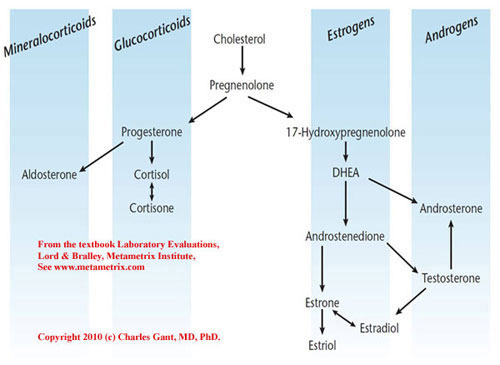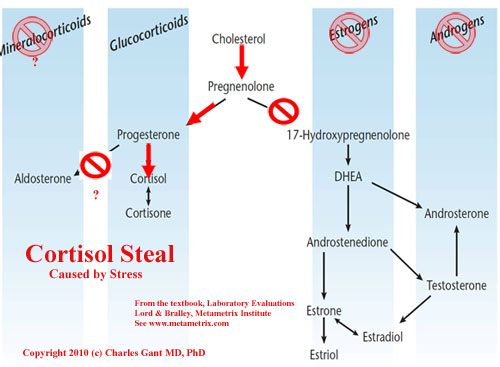You can learn how to reverse osteoporosis or prevent it by understanding the true root of the condition. According to an endocrine system expert, Dr. C.E. Gant, the primary contributing factor for osteoporosis is a lack of adequate progesterone, and this is most often caused by a condition called cortisol steal.
In his chart below, you will see a diagram illustrating the synthesis of all your steroid hormones. As you can see, cholesterol is the precursor to all these hormones. Without cholesterol, there would be no hormones. Cholesterol is then converted into pregnenolone, our mother hormone.
Then pregnenolone goes to the left and is converted into progesterone, cortisol, or aldosterone; or it goes to the right to be converted into DHEA, testosterone, and our estrogens.

Cortisol is the hormone we need when we are under stress, as it supports the body’s ability to cope with stress by counteracting its effects. The more stress you have, the more cortisol you need. If one is in a state of chronic stress, which includes much of the population, then there is a very high demand for cortisol.
So, in the next chart below we can see outlined in the red arrows that when there is a lot of stress, then all hormone precursors are going to be taken down to make cortisol and there isn’t any leftover to make progesterone, and other hormones like aldosterone, DHEA, etc. This is called cortisol steal. All the precursors are stolen to make cortisol. Thus our progesterone levels decline, and so do other hormones. So, this is also an explanation for one of the most common causes of hormones being out of balance as well.

Since the body simply cannot survive without cortisol, the body will sacrifice other less vital hormones to keep us alive.
So, what does this have to do with how to reverse osteoporosis or prevent it? For one, when we are under stress, cortisol directly reduces the formation of bone, because the body is busy dealing with the stress, it doesn’t have energy for things like building bone. So, if one remains in a chronic state of stress, then there isn’t a lot of bone-building going on.
Furthermore, progesterone stimulates osteoblasts (bone-building cells), that produce new bone. Estrogen inhibits the breakdown of old bone, so it plays some role as well, but progesterone must be present in order to build new bone.
When a woman approaches the perimenopause and menopausal years, this puts a lot of stress on the body, which as we learned above results in cortisol steal, and then progesterone is not available to form new bone. DHEA increases bone density, so if DHEA is low, it won’t be available to assist with this job either.
Progestins (synthetic progesterone), which are often prescribed to menopausal and perimenopausal women, do not stimulate osteoblasts, so they do not have any positive impact on osteoporosis. So it is crucial that progesterone be replenished with natural bio-identical progesterone, not synthetic. Additionally, it is best if it is transdermal, so that it will bypass the liver. If progesterone is taken orally, then it has to be processed by the liver, which may decrease its effectiveness and put more demand on the liver that is often overloaded already.
Furthermore, since estrogen has no impact on bone formation either, supplementation with synthetic estrogen will have no impact on osteoporosis. Not only that, these synthetic estrogens may be broken down into carcinogenic metabolites, thus increasing the risk for breast and ovarian cancer.
Now, you may have heard of some studies that claim that progesterone is not effective against osteoporosis, but the problem was that they didn’t supplement with progesterone for long enough. According to Dr. Gant, the endocrine system heals at the pace of a turtle, so you must allow at least 6 months before seeing any measurable changes in bone building, and at least a year for changes in bone density. It could even take two to five years.
Dr. Gant tells us that we can turn off osteoporosis completely tomorrow with bio-identical progesterone, as it is virtually one hundred percent effective. He states he has treated hundreds of women successfully, but of course, this should be combined with other essentials like vitamin D and K, calcium, balancing pH, stress management, a healthy primal diet, and regular but gentle exercise.
However, if you have chronic stress and your adrenal glands are weak, you need to be careful with progesterone supplementation; because progesterone has an inhibiting effect on aldosterone, the hormone that regulates your blood pressure, and blood pressure could become too low. If one is taking an anti-hypertension medication that works by inhibiting aldosterone, this could lower blood pressure too much as well, when taken in conjunction with progesterone.
Since cortisol steal sets the stage for insufficient progesterone, we want to engage in the frequent use of stress-management tools to try and prevent this from happening, like deep breathing exercises and mindfulness-based meditation, and yoga.
Other factors that can affect your progesterone levels are common everyday chemicals found in pesticides, herbicides, cosmetics, plastics, household cleaning supplies, air fresheners, personal care products, etc. These toxins can increase your estrogen level and decrease your progesterone. Additionally, candida yeast eats progesterone, so if you have an overgrowth of candida, this can be a contributing factor as well.
Equally important as taking in enough calcium, is how much calcium you excrete; if your body is too acidic then you will be excreting too much calcium in your urine. It is your acid-base balance that determines how much calcium you lose. Your body’s largest reservoir of alkaline base is in your bones, so it pulls from there when acid is high. So, essentially, an acidic diet will leach calcium from your bones. When this occurs repeatedly, over time it can lead to loss of bone density and osteoporosis.
The foods and substances that contribute the most to an acidic body include sugar, grains, alcohol, coffee, chocolate, cigarettes, artificial sweeteners, processed foods, legumes, deep-fried foods, salt, carbonated beverages, and pharmaceutical and recreational drugs.
Meat, eggs, seafood, and dairy are also acidic, but when they are consumed with liberal amounts of alkalizing vegetables, then the vegetables will neutralize the acid and result in a balanced pH level. You don’t want the diet to be too alkaline either, or this will encourage the proliferation of unfriendly organisms in the gut like Candida and bacteria.
As you see in the chart above you must have adequate levels of cholesterol to make progesterone, therefore it is vital to eat a diet that is rich in animal protein and fat and maintain sufficient levels of cholesterol. Having low cholesterol will contribute to the development of osteoporosis. According to Dr. Gant cholesterol under 160 is dangerous and other research like the Framingham Study suggests we may be better above 200.
Hormone testing (progesterone, estrogen, testosterone) can be done to assess one’s hormone levels and a cortisol saliva test can be used to assess your cortisol levels and see if cortisol steal is occurring. A Dexa Scan, which measures bone density, and a bone resorption assessment should be used to monitor osteoporosis progress and results from progesterone supplementation.
So, in a nutshell, the answer to how to reverse osteoporosis or prevent it from occurring in the first place is that you simply need to increase your progesterone, eat a diet that provides your body with adequate levels of nutrients and cholesterol, maintain a healthy pH, manage your stress, address any conditions that may be contributing to your total stress load, avoid estrogenic chemicals in the environment, address Canida overgrowth if present, and possibly use bio-identical hormone therapy.
Sources for How to Reverse Osteoporosis
Gant, Charles, M.D., Webinar, Endocrine (Adrenal) Stress #2. July 15, 2010.
Elias, P. K. “Serum Cholesterol and Cognitive Performance in the Framingham Heart Study.” Psychosomatic Medicine 67.1 (2005): 24-30. Print.
Professor Loren Cordain. The Paleo Diet. Wiley, 2001
